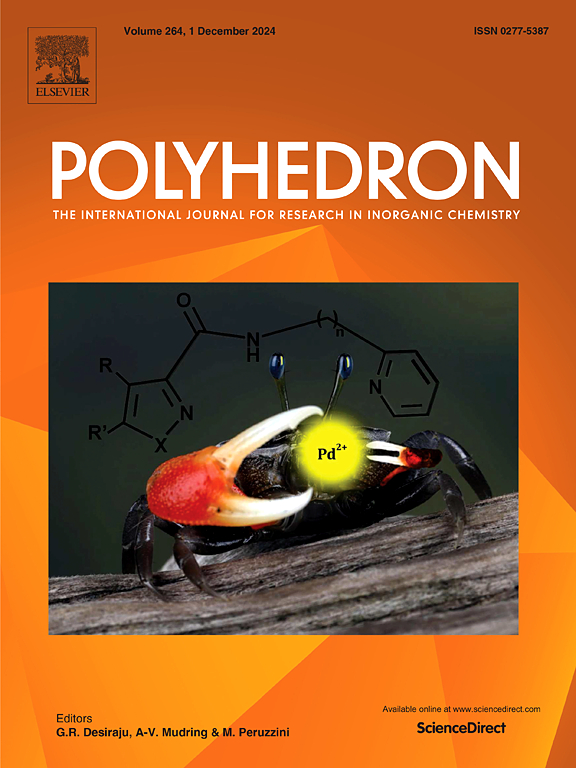Understanding binding behavior of human carbonic anhydrase II with aromatic benzenesulfonamides by molecular dynamics simulations and biophysical characterization
IF 2.6
3区 化学
Q2 CHEMISTRY, INORGANIC & NUCLEAR
引用次数: 0
Abstract
Human carbonic anhydrase II (HCAII) catalyzes the hydrolysis of carbon dioxide to form the bicarbonate ion and a proton. The active site of HCAII contains a Zn2+ ion and three histidine residues located between hydrophobic and hydrophilic pockets. Sulfonamides can bind to the active site zinc and inhibit the enzyme. We have investigated a series of new inhibitor-based benzenesulfonamides for HCAII inhibition. Molecular docking and molecular dynamics (MD) calculations were used to determine how the inhibitors interact with HCAII, and Molecular Mechanics-Generalized Born Surface Area (MM/GBSA) calculations were used to calculate binding free energies and important interactions. Circular dichroism data showed a notable change in the protein structure when para-aminobenzenesulfonamide and 2-nitroimidazole-benzenesulfonamide bind to zinc(II), which was explained by the root mean squared fluctuation and secondary structure elements analysis. The MM/GBSA calculations gave binding affinities that are much more negative but in the same relative order as the measured binding affinities. Among a series of new inhibitors, ortho-9-amino-4,5-diazafluorenebenzenesulfonamide, ortho-9-amino-4,5-diazafluorenebenzenesulfonamide, and PaQ exhibited the most significant binding affinity to HCAII, making them promising candidates for further research in drug discovery or catalysis.

通过分子动力学模拟和生物物理表征了解人碳酸酐酶II与芳香苯磺酰胺的结合行为
人碳酸酐酶II (HCAII)催化二氧化碳水解形成碳酸氢盐离子和质子。HCAII的活性位点包含一个Zn2+离子和三个组氨酸残基,位于疏水性和亲水性口袋之间。磺胺类药物能与活性位点锌结合,抑制酶的活性。我们研究了一系列新的基于抑制剂的苯磺酰胺对HCAII的抑制作用。通过分子对接和分子动力学(MD)计算确定抑制剂如何与HCAII相互作用,并通过分子力学-广义出生表面积(MM/GBSA)计算计算结合自由能和重要相互作用。圆形二色性数据显示,对氨基苯磺酰胺和2-硝基咪唑-苯磺酰胺与锌(II)结合时,蛋白质结构发生了显著变化,这可以用均方根波动和二级结构元素分析来解释。MM/GBSA计算得到的结合亲和力负得多,但与测量的结合亲和力的相对顺序相同。在一系列新的抑制剂中,邻9-氨基-4,5-二氮芴苯磺酰胺、邻9-氨基-4,5-二氮芴苯磺酰胺和PaQ对HCAII的结合亲和力最显著,这使得它们在药物发现或催化方面有进一步的研究前景。
本文章由计算机程序翻译,如有差异,请以英文原文为准。
求助全文
约1分钟内获得全文
求助全文
来源期刊

Polyhedron
化学-晶体学
CiteScore
4.90
自引率
7.70%
发文量
515
审稿时长
2 months
期刊介绍:
Polyhedron publishes original, fundamental, experimental and theoretical work of the highest quality in all the major areas of inorganic chemistry. This includes synthetic chemistry, coordination chemistry, organometallic chemistry, bioinorganic chemistry, and solid-state and materials chemistry.
Papers should be significant pieces of work, and all new compounds must be appropriately characterized. The inclusion of single-crystal X-ray structural data is strongly encouraged, but papers reporting only the X-ray structure determination of a single compound will usually not be considered. Papers on solid-state or materials chemistry will be expected to have a significant molecular chemistry component (such as the synthesis and characterization of the molecular precursors and/or a systematic study of the use of different precursors or reaction conditions) or demonstrate a cutting-edge application (for example inorganic materials for energy applications). Papers dealing only with stability constants are not considered.
 求助内容:
求助内容: 应助结果提醒方式:
应助结果提醒方式:


